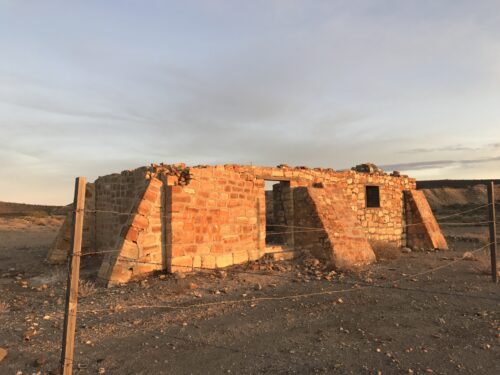The Baja peninsula is home to many quirky spots and small pockets of history and natural wonder. One of these is the abandoned El Mármol Quarry, located in the Central Desert. While El Mármol literally translates to the marble, it was actually white onyx that was mined here and used all over the world.
The mine was discovered in the 1890s. Carbonated springs (that still bubble nearby at Arroyo El Volcán) created onyx that came in tints of green, rose, yellow, brown, and—most abundantly, and famously—in a creamy white. The onyx that was discovered here became incredibly popular as it was located much closer to the U.S. than other onyx quarries in Algeria or mainland Mexico. And although there were some onyx quarries in the U.S., the onyx mined from El Mármol was of a higher quality and was found in larger pieces. At one point, El Mármol was the largest onyx quarry on earth.
During its operation, the mine shipped onyx around the world to markets in England, Belgium, Asia, and the United States to be used for mantels, tabletops, and smaller decorative items in addition to use in architecture such as the interiors of churches.
 There were two main challenges that the miners at El Mármol were up against—the lack of fresh water (which had to be brought in by barrel), and the remote location of the mine for exporting the ore. Once the onyx ore was mined it was transported 60 miles west in wagons pulled by 16 mules to Santa Catarina at the Pacific Ocean. The roundtrip took five days to complete. Once the ore made it to the coast, it was carried by specialized pangas out to steamships that took up to San Diego for processing and distribution around the world.
There were two main challenges that the miners at El Mármol were up against—the lack of fresh water (which had to be brought in by barrel), and the remote location of the mine for exporting the ore. Once the onyx ore was mined it was transported 60 miles west in wagons pulled by 16 mules to Santa Catarina at the Pacific Ocean. The roundtrip took five days to complete. Once the ore made it to the coast, it was carried by specialized pangas out to steamships that took up to San Diego for processing and distribution around the world.
The mine operators and the laborers and their families formed a small village of over 100 people who lived at El Mármol. Of the numerous buildings in the village, the one-room schoolhouse that was built entirely from white onyx is the most famous building and the only one that remains today. It is the world’s only schoolhouse made entirely of onyx.
After World War II, new materials and building styles replaced the use of onyx in architecture. The growing use of plastics replaced onyx in smaller decorative items. El Mármol quarry eventually closed in 1958.

To visit the remains of El Mármol today, look for the turn off from Mexico 1 between El Rosario and Cataviña at Km. 148. Drive 15 kilometers east of Highway Mexico 1 on a graded dirt road until you reach the deserted quarry. You’ll still find large slabs of onyx laying around on the ground. The only building remaining is the old schoolhouse that was built entirely with blocks of cream onyx.
If you don’t make it out to El Mármol, you can still find the famous onyx on the floor of the entrance to the Hotel Misión Cataviña, which is decorated with an ornate inlay of cream onyx from the mine. Or north of the border, the Spreckles Theater in downtown San Diego has an entrance, lobby, walls, and ceiling that are decorated in onyx from El Mármol.

Traveled and camped in the early 70s. There were several buildings and old solid rubber tired trucks, as well as poles with block and tackles for lifting quarried rocks out. There was an old gas powered compressor. The fan would spin in the wind. It was eerie in the quiet of the place.
One indication of the size of the town is the fairly extensive cemetery there. Watch out
for some of the still open pits nearby along with an abundant supply of healthy sage plants for trimmings.
One of the tales that we heard back in the 80s when first visiting the site was that the actress Theda Bara’s bathtub was carved from this local onyx.